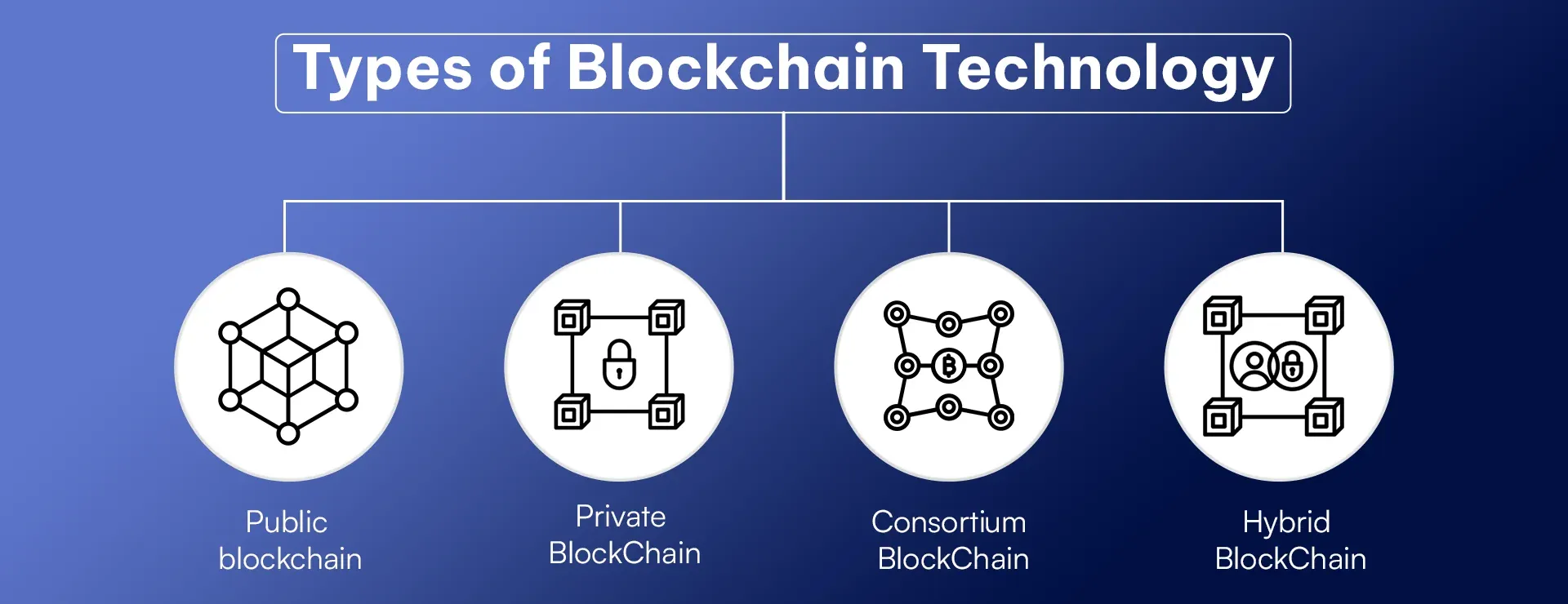 Recently, blockchain technology gained massive growth because it supports secure, decentralized, and transparent record keeping. Not all blockchains are the same, though. They can be categorized into four different types: Public, Private, Consortium, and Hybrid blockchains. Each serves a purpose, offers unique advantages and disadvantages, and is suited to specific use cases, among other things. Here's a detailed look at these four types of blockchains so you'll know which one might be the best fit for your needs.
Recently, blockchain technology gained massive growth because it supports secure, decentralized, and transparent record keeping. Not all blockchains are the same, though. They can be categorized into four different types: Public, Private, Consortium, and Hybrid blockchains. Each serves a purpose, offers unique advantages and disadvantages, and is suited to specific use cases, among other things. Here's a detailed look at these four types of blockchains so you'll know which one might be the best fit for your needs.
Quick Summary
In this blog, we are going to outline the four main categories of blockchain technology: Public, Private, Consortium, and Hybrid blockchains. Each of these has its pros and cons and would thus be more suitable for particular applications within different industries.
Public blockchains are open source and decentralized; hence, they are ideal for more transparent or trust-based cryptocurrencies and DeFi but are often not scalable.
Private blockchains limit access since they give more control and speed. Hence, they seem to be the best answer for finance and healthcare but lead to the most threatening threat of centralization.
The consortium blockchain is governed by many organizations; on one hand, it is towards cooperation and on another, decentralization is more congenial to shared resources, but for effective governance, it requires hybrid blockchains that integrate both concepts into themselves; they are natural hybrids as they allow flexible management of data with public verification, hence suitable for digital identity but complex to execute.
4 Types of Blockchain Technology
Blockchain technology includes public, private, consortium, and hybrid types. Public blockchains are open to all, private ones limit access, consortiums are shared among trusted organizations, and hybrids blend public-private access. Each type supports unique needs, balancing transparency, security, and privacy across industries like finance and supply chains.

1. Public Blockchain
Public blockchains are an open and decentralized network. Anyone, be it a participant or not, can join the network, validate transactions, and even access the data within the blockchain. Since they depend on consensus mechanisms that are mostly proof of work or proof of stake, users can secure the network.
Advantages
- Transparency: All transactions can be viewed, so this creates more accountability.
- Decentralization: There is no central authority that controls the network, and therefore, the possibility of manipulation is minimal.
- Security: It has a distributed nature that cannot be easily altered by malicious actors.
Disadvantages
- Scalability Issues: The system is relatively slow, and fees can be high during peak hours.
- Energy Consumption: It involves an utterly high energy consumption, especially when involving proof-of-work schemes.
- Privacy: All transactions are public, which is not ideal when the information being transmitted is quite sensitive.
Use Cases
- Cryptocurrencies: Bitcoin as well as Ethereum are perfect examples of public blockchains.
- Decentralized Applications (dApps): Many applications work on public blockchains to demonstrate transparency.
- Supply Chain Tracking: A corporation can track the product provenance publicly.
2. Private Blockchain
Private blockchains are limited networks. Only certain allowed participants can validate the transactions. These blockchains are mostly managed by a single organization or consortium. Therefore, more control over the data may be observed.
Advantages
- Control: Organizations may maintain control over who can access and who can validate in the network.
- Speed and Efficiency: Faster processing because of the limited number of participants.
- Privacy: The data can be kept confidential, as it may be suitable for highly sensitive information
Disadvantages
- Centralization: It is controlled by a single entity that could be exposed to vulnerabilities.
- Less Transparency: It may reduce the visibility, increasing the distrust between participants.
- Fewer Security Features: The closed system might be more susceptible to insider scams.
Use Cases
- Enterprise Solutions: IBM and Hyperledger use private blocks for fast, secure transactions.
- Financial Institutions: Private blocks may be used by banks for real-time settlement details and transaction reports.
- Data Management: Organizations may manage sensitive data confidentially without making them public.
Also read this article : What is generative AI?
3. Consortium Blockchain
The consortium blockchain is a semi-decentralized network where several organizations are in charge of the blockchain. Access is limited to a pre-defined set of participants, which essentially gives a middle ground between public and private blockchains.
Advantages
- Collaboration: Shared resources with shared efforts by several organizations.
- Security: There is a lower risk for a single point of failure with a distributed control model.
- Efficiency: Transaction speed is much faster compared to the public blockchain because fewer people use it.
Disadvantages
- Complex Governance: Sometimes, it is hard to create governance models with more than one stakeholder involved.
- Access: Far from public blockchains. This may keep some away and use it less.
- Trust: People have to trust the participants, which may be an important problem in competitive businesses.
Use Cases
Supply Chain Management: Companies can partner for the tracking as well as the authenticity of products.
Healthcare: Distinct organizations may share patient data safely while remaining private, thus boosting security as well as keeping those who need not see each other's data separate.
Trade Finance: Institutions may share data safely to smooth processes.
4. Hybrid Blockchain
Hybrid blockchains include elements of both public and private blockchains. It is flexible and balanced between the aspects of transparency and control. Organizations can decide what data is private and what data is supposed to be shared publicly.
Advantages
- Flexibility: Organizations can customize their blockchain according to specific needs.
- Improved Security: Sensitive information can be kept private; however, public verification may also be allowed.
- Scalability: It provides more scalable solutions, as it accommodates various speeds of transactions.
Disadvantages
- Complexity: Hybrid can be more complex compared to other models.
- Integration Issues: It may also require integration with existing systems, thereby adding to the development time.
- Cost: It is more expensive to establish and run a hybrid blockchain compared to others
Use Cases
- Government Applications: Hybrid blockchains can be very very useful in governments to securely manage public records while still allowing public access to some information on them.
- IoT Devices: They can securely connect and manage data from IoT devices by making use of hybrid blockchains.
- Digital Identity: An organization maintains identities within their boundaries but provides public verifiability of at least some facets.
Conclusion
It is important for businesses and individuals to know the various blockchain types. Each of the four major blockchain types, Public, Private, Consortium, and Hybrid, has a strength and weakness.
Public blockchains allow for transparency and decentralization but might cause significant problems with scalability. Private blockchains are controlled and efficient. Financial organizations and healthcare would greatly benefit from private blockchains but introduce vulnerabilities. Consortium blockchains make it easier for organizations to collaborate, and Hybrid blockchains make it easier to use any type of data management.
Therefore, choosing a type of blockchain depends entirely on what the organization needs from it: control, transparency, scalability, or security. Keeping up with blockchain developments will help organizations tap into this potential and achieve any kind of competitive advantage in the coming data-driven world.
For expert guidance on integrating advanced technologies, Rejoicehub LLP offers AI/ML services to support businesses in achieving their digital transformation goals.
Frequently Asked Questions
1. What's The Difference Between Public And Private Blockchains?
A public blockchain is so open that anyone can join it, which promotes a certain level of transparency, whereas a private blockchain is only accessible to a handful of participants, hence allowing more control and privacy.
2. Is A Consortium Blockchain Decentralized?
Yes, consortium blockchains are semi-decentralized and represent a compromise between public blockchains where multiple organizations govern for less single-point-of-failure risks.
3. Which Sectors Benefit From Hybrid Blockchains?
Hybrid blockchains are useful for industries like government, healthcare, and IoT because they both types of data can be handled-private and public.
4. Are Public Blockchains That Secure?
Public blockchains are largely very secure because they are decentralized, but for some attacks, for instance, 51% of attacks are possible in case the majority of the network falls into the hands of a single entity.
5. How Can I Choose The Most Suitable Type Of Blockchain For My Project?
Determine what your project needs, be it transparency, control, scalability, and security, to determine which blockchain type will work best for you.
